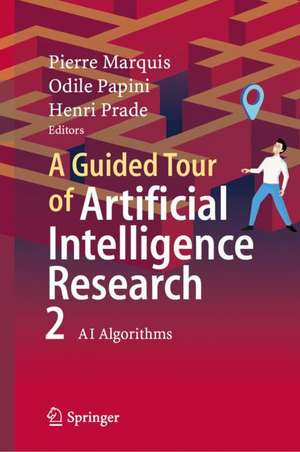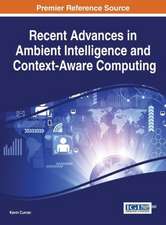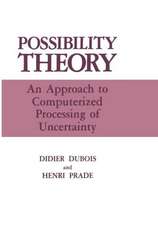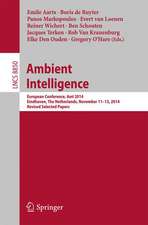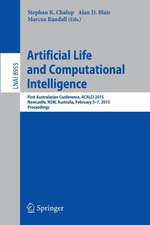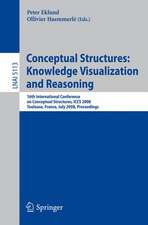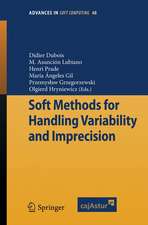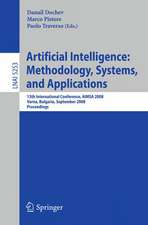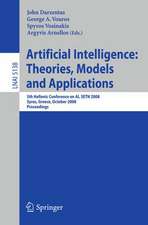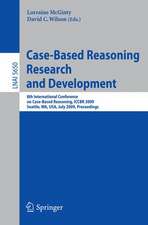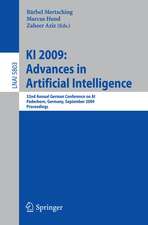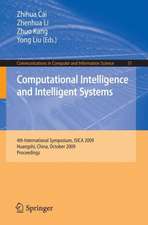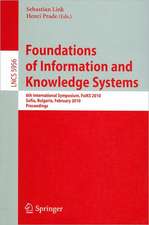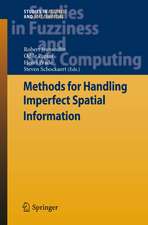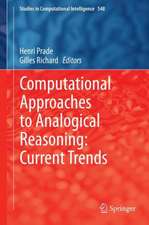A Guided Tour of Artificial Intelligence Research: Volume II: AI Algorithms
Editat de Pierre Marquis, Odile Papini, Henri Pradeen Limba Engleză Hardback – 9 mai 2020
The purpose of this book is to provide an overview of AI research, ranging from basic work to interfaces and applications, with as much emphasis on results as on current issues. It is aimed at an audience of master students and Ph.D. students, and can be of interest as well for researchers and engineers who want to know more about AI. The book is split into three volumes:
- the first volume brings together twenty-three chapters dealing with the foundations of knowledge representation and the formalization of reasoning and learning (Volume 1. Knowledge representation, reasoning and learning)
- the second volume offers a view of AI, in fourteen chapters, from the side of the algorithms (Volume 2. AI Algorithms)
- the third volume, composed of sixteen chapters, describes the main interfaces and applications of AI (Volume 3. Interfaces and applications of AI).
This second volume presents the main families of algorithms developed or used in AI to learn, to infer, to decide. Generic approaches to problem solving are presented: ordered heuristic search, as well as metaheuristics are considered. Algorithms for processing logic-based representations of various types (first-order formulae, propositional formulae, logic programs, etc.) and graphical models of various types (standard constraint networks, valued ones, Bayes nets, Markov random fields, etc.) are presented. The volume also focuses on algorithms which have been developed to simulate specific ‘intelligent” processes such as planning, playing, learning, and extracting knowledge from data. Finally, an afterword draws a parallel between algorithmic problems in operation research and in AI.
- the first volume brings together twenty-three chapters dealing with the foundations of knowledge representation and the formalization of reasoning and learning (Volume 1. Knowledge representation, reasoning and learning)
- the second volume offers a view of AI, in fourteen chapters, from the side of the algorithms (Volume 2. AI Algorithms)
- the third volume, composed of sixteen chapters, describes the main interfaces and applications of AI (Volume 3. Interfaces and applications of AI).
This second volume presents the main families of algorithms developed or used in AI to learn, to infer, to decide. Generic approaches to problem solving are presented: ordered heuristic search, as well as metaheuristics are considered. Algorithms for processing logic-based representations of various types (first-order formulae, propositional formulae, logic programs, etc.) and graphical models of various types (standard constraint networks, valued ones, Bayes nets, Markov random fields, etc.) are presented. The volume also focuses on algorithms which have been developed to simulate specific ‘intelligent” processes such as planning, playing, learning, and extracting knowledge from data. Finally, an afterword draws a parallel between algorithmic problems in operation research and in AI.
| Toate formatele și edițiile | Preț | Express |
|---|---|---|
| Hardback (3) | 1173.93 lei 3-5 săpt. | |
| Springer International Publishing – 9 mai 2020 | 1173.93 lei 3-5 săpt. | |
| Springer International Publishing – 8 mai 2020 | 1177.25 lei 3-5 săpt. | |
| Springer International Publishing – 9 mai 2020 | 1309.20 lei 3-5 săpt. |
Preț: 1173.93 lei
Preț vechi: 1467.42 lei
-20% Nou
Puncte Express: 1761
Preț estimativ în valută:
224.66€ • 243.95$ • 188.71£
224.66€ • 243.95$ • 188.71£
Carte disponibilă
Livrare economică 01-15 aprilie
Preluare comenzi: 021 569.72.76
Specificații
ISBN-13: 9783030061661
ISBN-10: 3030061663
Pagini: 370
Ilustrații: XV, 523 p. 121 illus., 25 illus. in color.
Dimensiuni: 155 x 235 mm
Greutate: 0.86 kg
Ediția:1st ed. 2020
Editura: Springer International Publishing
Colecția Springer
Locul publicării:Cham, Switzerland
ISBN-10: 3030061663
Pagini: 370
Ilustrații: XV, 523 p. 121 illus., 25 illus. in color.
Dimensiuni: 155 x 235 mm
Greutate: 0.86 kg
Ediția:1st ed. 2020
Editura: Springer International Publishing
Colecția Springer
Locul publicării:Cham, Switzerland
Cuprins
From the content: Heuristically Ordered Search in State Graphs.- Meta-Heuristics and Artificial Intelligence.- Automated Deduction.
Textul de pe ultima copertă
The purpose of this book is to provide an overview of AI research, ranging from basic work to interfaces and applications, with as much emphasis on results as on current issues. It is aimed at an audience of master students and Ph.D. students, and can be of interest as well for researchers and engineers who want to know more about AI. The book is split into three volumes:
- the first volume brings together twenty-three chapters dealing with the foundations of knowledge representation and the formalization of reasoning and learning (Volume 1. Knowledge representation, reasoning and learning)
- the second volume offers a view of AI, in fourteen chapters, from the side of the algorithms (Volume 2. AI Algorithms)
- the third volume, composed of sixteen chapters, describes the main interfaces and applications of AI (Volume 3. Interfaces and applications of AI).
This second volume presents the main families of algorithms developed or used in AI tolearn, to infer, to decide. Generic approaches to problem solving are presented: ordered heuristic search, as well as metaheuristics are considered. Algorithms for processing logic-based representations of various types (first-order formulae, propositional formulae, logic programs, etc.) and graphical models of various types (standard constraint networks, valued ones, Bayes nets, Markov random fields, etc.) are presented. The volume also focuses on algorithms which have been developed to simulate specific ‘intelligent” processes such as planning, playing, learning, and extracting knowledge from data. Finally, an afterword draws a parallel between algorithmic problems in operation research and in AI.
- the first volume brings together twenty-three chapters dealing with the foundations of knowledge representation and the formalization of reasoning and learning (Volume 1. Knowledge representation, reasoning and learning)
- the second volume offers a view of AI, in fourteen chapters, from the side of the algorithms (Volume 2. AI Algorithms)
- the third volume, composed of sixteen chapters, describes the main interfaces and applications of AI (Volume 3. Interfaces and applications of AI).
This second volume presents the main families of algorithms developed or used in AI tolearn, to infer, to decide. Generic approaches to problem solving are presented: ordered heuristic search, as well as metaheuristics are considered. Algorithms for processing logic-based representations of various types (first-order formulae, propositional formulae, logic programs, etc.) and graphical models of various types (standard constraint networks, valued ones, Bayes nets, Markov random fields, etc.) are presented. The volume also focuses on algorithms which have been developed to simulate specific ‘intelligent” processes such as planning, playing, learning, and extracting knowledge from data. Finally, an afterword draws a parallel between algorithmic problems in operation research and in AI.
Caracteristici
Presents an up-to-date overview of past and present research Offers a carefully edited complete tour Complements the other two volumes on knowledge representation and reasoning, and on interfaces and applications of AI
